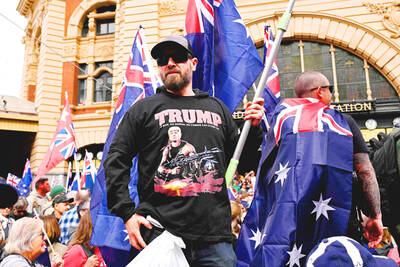On a quiet street lined with 18th-century Georgian houses behind Westminster Abbey, Garry Usher winds the mechanical clock on a gas street lamp and gives the glass globe a polish.
He steps down off his ladder and looks up with satisfaction as the soft, warm light lifts the dark winter evening, and moves on down the street.
Despite nationwide budget cuts that have reduced local services and seen streetlights dimmed to save money, 1,500 gas lamps in London are still maintained by hand.

Photo: AFP
They are the last of tens of thousands of lamps that were first introduced in the capital 200 years ago, a marvel of modern technology that brought life to the once dark and dangerous streets.
While many London residents are oblivious to their presence, the lamps are protected by local authorities as a piece of history — and new ones are even being installed.
“They’re lovely. It’s a fantastic form of lighting, not as harsh as electric,” Usher said as he went on his rounds.
The 50-year-old, an engineer with the British Gas energy firm, used to maintain central heating, but began working on the lamps because it gave him Saturdays off to play rugby union.
Now he leads a team involving four other “lamplighters” who maintain the lamps, half of which still have mechanical clocks that need winding every 14 days.
The others run on electrical timers, which need their batteries changed every six months, while the various parts also need checking regularly.
“You’re touching history everywhere you go — it’s a privileged job,” Usher said.
Gas lamps became common across Europe in the mid-19th century. Before that, walking the streets at night was a dangerous business.
In London, you could pay a “link boy” a farthing to guide your way with a candle, but there was always a risk he might rob you blind.
Initial reaction to the first demonstration of gas lights in 1807 — the first on any street in the world — was mixed, not least because the early gas lines could be dangerous and there was the odd explosion.
However, when King George IV ordered their widespread introduction in 1814, they quickly caught on.
Some lamps served a dual purpose of lighting the streets and clearing the smells from London’s underground sewers.
The Webb Sewer lamp drew up gases from the sewers down below and burnt it off. One such functioning lamp still exists, next to the Savoy Hotel near the River Thames.
As late as the 1970s, many gas lamps in London were still lit by hand each evening and extinguished every morning.
Now they all have a permanent pilot light burning and the mains gas flows on a timer, heating up the “mantles” — small ceramic meshes resembling bulbs, that become white hot and give off a glowing light.
They lend a magical quality to the streets, and in St James’ Park — near Buckingham Palace — they are the only source of light, offering a rare glimpse into what it might have looked like in Dickensian times.
The lamps survived the arrival of electricity and the Blitz bombings in World War II, and these days the biggest threat is the traffic.
Originally designed to stand taller than a horse and cart, many have been extended upward to stay out of the way of trucks, although some still get hit and must be repaired.
However, they are not just about history.
A number of new gas lamps have been installed in recent years, including one requested by the architect behind the new Apple store in Covent Garden.
“There’s no chance of these lamps disappearing,” British Gas operations manager Iain Bell said. “If anything, we’re getting more calls to install them.”

Australia has announced an agreement with the tiny Pacific nation Nauru enabling it to send hundreds of immigrants to the barren island. The deal affects more than 220 immigrants in Australia, including some convicted of serious crimes. Australian Minister of Home Affairs Tony Burke signed the memorandum of understanding on a visit to Nauru, the government said in a statement on Friday. “It contains undertakings for the proper treatment and long-term residence of people who have no legal right to stay in Australia, to be received in Nauru,” it said. “Australia will provide funding to underpin this arrangement and support Nauru’s long-term economic

‘NEO-NAZIS’: A minister described the rally as ‘spreading hate’ and ‘dividing our communities,’ adding that it had been organized and promoted by far-right groups Thousands of Australians joined anti-immigration rallies across the country yesterday that the center-left government condemned, saying they sought to spread hate and were linked to neo-Nazis. “March for Australia” rallies against immigration were held in Sydney, and other state capitals and regional centers, according to the group’s Web site. “Mass migration has torn at the bonds that held our communities together,” the Web site said. The group posted on X on Saturday that the rallies aimed to do “what the mainstream politicians never have the courage to do: demand an end to mass immigration.” The group also said it was concerned about culture,

ANGER: Unrest worsened after a taxi driver was killed by a police vehicle on Thursday, as protesters set alight government buildings across the nation Protests worsened overnight across major cities of Indonesia, far beyond the capital, Jakarta, as demonstrators defied Indonesian President Prabowo Subianto’s call for calm. The most serious unrest was seen in the eastern city of Makassar, while protests also unfolded in Bandung, Surabaya, Solo and Yogyakarta. By yesterday morning, crowds had dispersed in Jakarta. Troops patrolled the streets with tactical vehicles and helped civilians clear trash, although smoke was still rising in various protest sites. Three people died and five were injured in Makassar when protesters set fire to the regional parliament building during a plenary session on Friday evening, according to

STILL AFLOAT: Satellite images show that a Chinese ship damaged in a collision earlier this month was under repair on Hainan, but Beijing has not commented on the incident Australia, Canada and the Philippines on Wednesday deployed three warships and aircraft for drills against simulated aerial threats off a disputed South China Sea shoal where Chinese forces have used risky maneuvers to try to drive away Manila’s aircraft and ships. The Philippine military said the naval drills east of Scarborough Shoal (Huangyan Island, 黃岩島) were concluded safely, and it did not mention any encounter with China’s coast guard, navy or suspected militia ships, which have been closely guarding the uninhabited fishing atoll off northwestern Philippines for years. Chinese officials did not immediately issue any comment on the naval drills, but they